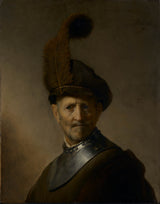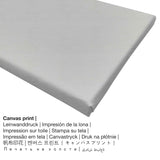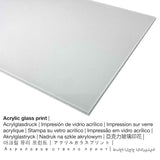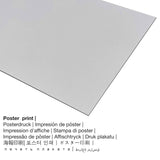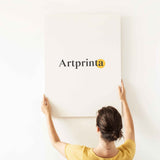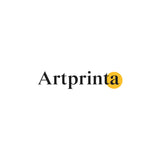Rembrandt van Rijn, 1631 - Lehilahy antitra manao akanjo miaramila - printy tsara tarehy
Tafiditra ao anatiny. Kajy ny fandefasana amin'ny fisavana.
Fanazavana ny vokatra
Tamin'ny 1631 ny mpanao hosodoko Rembrandt Van Rijn made the masterpiece. This work of art forms part of the collection of Ny Museum J. Paul Getty, which is part of the J. Paul Getty trust and is one of the world's largest arts organizations worldwide. It seeks to inspire curiosity about, and enjoyment and understanding of, the visual arts by collecting, conserving, exhibiting, and interpreting works of art of outstanding quality and historical importance.. The classic art bahoaka asa kanto dia omena amin'ny fanajana ny Ny Museum J. Paul Getty.Creditline ny sangan-kanto: . Ankoatra izany, ny fampifanarahana ny famokarana nomerika dia Mombamomba ny mpanoratra miaraka amin'ny lafiny lafiny 3: 4, which means that the length is 25% shorter than the width. Rembrandt van Rijn was a male painter, whose art style can be classified as Baroque. The Baroque artist was born in 1606 tany Leiden ary maty teo amin’ny faha-taonany 63 tamin'ny 1669 tany Amsterdam.
Fidio ny karazana fitaovana vokatra tianao
Manolotra karazana habe sy fitaovana isan-karazany izahay ho an'ny vokatra tsirairay. Azonao atao ny misafidy amin'ireto safidy fanamboarana vokatra manaraka ireto:
- Acrylic fitaratra pirinty: A glossy print on acrylic glass, often labelled as a print on plexiglass, will transform the original artwork into stunning décor. Your own replica of the artwork is made with the help of modern UV direct printing technology. This creates the effect of vibrant, deep colors.
- Canvas print: The printed canvas material mounted on a wood stretcher frame. A canvas print produces a lovely and pleasing effect. How can I hang a canvas print on my wall? The advantage of canvas prints is that they are relatively low in weight, which means that it is quite simple to hang your Canvas print without any wall-mounts. Canvas prints are suitable for any kind of wall.
- Fanontana afisy (fitaovana canvas): A poster is a UV printed sheet of canvas paper with a slightly roughened surface structure, that reminds the original artwork. The poster print is optimally designed for placing the art print with a custom frame. Please bear in mind, that depending on the absolute size of the poster we add a white margin 2-6cm round about the artwork in order to facilitate the framing with a custom frame.
- Aluminum dibond printy: An Aluminium Dibond print is a material with a true depth. For our Direct Print On Aluminum Dibond, we print your work of art on the aluminium white-primed surface. The bright & white components of the artwork shimmer with a silk gloss, however without any glow. The colors of the print are luminous, fine details of the print are clear and crisp. The direct UV print on aluminium is the most popular entry-level product and is a truly stylish way to display art, as it puts the viewer’s focus on the whole artwork.
Fialana andraikitra ara-dalàna: We try whatever we can to depict the products as precisely as possible and to exhibit them visually on the different product detail pages. Nevertheless, some pigments of the print materials and the printing might vary slightly from the image on the device's screen. Depending on the screen settings and the nature of the surface, color pigments may not be printed one hundret percent realistically. Bearing in mind that all are printed and processed by hand, there may as well be minor variations in the motif's size and exact position.
Fampahalalana lahatsoratra mirindra
| Fanasokajiana lahatsoratra: | famokarana kanto tsara |
| Fomba famokarana: | famokarana nomerika |
| Fomba fanamboarana: | UV pirinty / fanontana nomerika |
| Provenance: | Vita amin'ny Alemanina |
| Karazana tahiry: | on demand production |
| Fampiasana vokatra naroso: | galera fanontana zavakanto, rindrina galera |
| Fanitsiana: | fampifanarahana sary |
| tahan'ny lafiny: | 3: 4 lavany ho sakany |
| Fepetra: | ny lavany dia 25% fohy noho ny sakany |
| Fitaovana azonao isafidianana: | pirinty metaly (aluminium dibond), pirinty canvas, pirinty afisy (papier canvas), pirinty vera acryl (miaraka amin'ny coating vera tena izy) |
| Kanvas eo amin'ny sarin'ny tonta (canvas print): | 30x40sm - 12x16", 60x80sm - 24x31", 90x120sm - 35x47", 120x160sm - 47x63" |
| Fanontam-pirinty vita amin'ny vera acrylic (miaraka amin'ny fametahana fitaratra tena izy) variana habe: | 30x40sm - 12x16", 60x80sm - 24x31", 90x120sm - 35x47", 120x160sm - 47x63" |
| Afisy vita printy (taratasy canvas): | 30x40sm - 12x16", 60x80sm - 24x31", 90x120sm - 35x47" |
| Haben'ny printy Dibond (fitaovana alumnium): | 30x40sm - 12x16", 60x80sm - 24x31", 90x120sm - 35x47" |
| Fandrafetana sary pirinty: | tsy misy firafitra |
Fampahalalana momba ny zavakanto
| Lohatenin'ny zava-kanto: | "An Old Man in Military Costume" |
| Fanasokajiana sangan'asa: | hoso-doko |
| Sokajy: | kanto klasika |
| Time: | Taonjato faha 17 |
| Noforonina tamin'ny taona: | 1631 |
| Eo ho eo amin'ny taonan'ny zavakanto: | 380 taona |
| Museum / toerana: | Ny Museum J. Paul Getty |
| Toerana tranombakoka: | Los Angeles, Kalifornia, Etazonia |
| Pejy tranokalan'ny tranombakoka: | Ny Museum J. Paul Getty |
| Karazan-kanto nahazo alalana: | bahoaka |
| Nahazoana lalana avy amin'ny: | Ny Museum J. Paul Getty |
Tabilao famintinana mpanakanto
| Artist: | Rembrandt Van Rijn |
| Gender of the artist: | lahy |
| zom-pirenena: | Anarana iombonana |
| Asa: | mpanao hosodoko |
| Firenena mpanakanto: | ny Holandey |
| Fanasokajiana mpanakanto: | tompo taloha |
| Karazan-kanto: | Santionan'izany fiangaly |
| Faharetana: | 63 taona |
| teraka: | 1606 |
| Toerana nahaterahana: | Leiden |
| Taonan'ny fahafatesana: | 1669 |
| maty tany (toerana): | Amsterdam |
© Voaaro ny zon'ny mpamorona, Artprinta.com
Original information about the work of art from The J. Paul Getty Museum (© Copyright - The J. Paul Getty Museum - www.getty.edu)
The subject, who appears in different guises in several other paintings by Rembrandt van Rijn and his contemporaries, wears a plumed hat and metal breastplate. His military costume may symbolize Dutch strength and patriotism during the struggle for independence from Spain. Although he faces front, the man's torso is turned in a three-quarter view; his watery eyes gazing off to the side give the image a sense of immediacy.
Rembrandt deftly captured the contrasting textures of materials: the downiness of the ostrich feather, the velvety softness of the cap, and the smooth coldness of the metal breastplate. The furrowed skin around the bridge of the man's nose, the moistness of his eyes, and the wispiness of his mustache and beard map out the physical process of aging.

